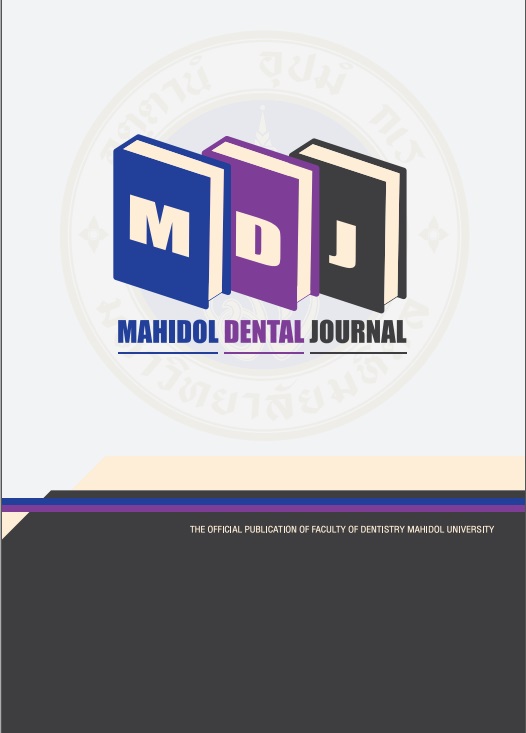Effect of the internal glaze on pull-off bond strength between Rely X Ultimate resin cement and zirconia crown
Main Article Content
Abstract
Objectives: To evaluate the effect of the internal glaze of Ceramill ZI zirconia crown on pull-off bond strength using RelyX Ultimate resin cement.
Materials and Methods: Twenty-four human upper premolar teeth were obtained. The teeth were prepared to create a flat occlusal surface, 16° total occlusal convergence, 0.8 mm deep chamfer margin, and 4 mm height. All specimens were divided randomly into two groups as internal glaze (ING) (n=12) and control groups (n=12). Each specimen was scanned and designed to fabricate 2 mm thickness crown. Subsequently, zirconia discs were milled and sintered. For the ING group, the internal surface of crowns was glazed by VITA AKZENT Plus glazing spray. The glaze surfaces were etched with 10% HF for 20 seconds, rinsed, cleaned, and air-dried. Single Bond Universal was applied to the specimens. Then, each specimen was cemented with RelyX Ultimate resin cement and the 50 N (Newton) load was applied during cementation. The crown pull-off test was performed by using a universal testing machine at a constant crosshead speed of 1 mm/min. A T-test was used for statistical analysis. The tooth surface and zirconia crowns from the crown pull-off test were examined by a light microscope and scanning electron microscope.
Results: Compared to the control group, the mean pull-off bond strength of internal glaze group groups did not increase the bond strength of resin cement to zirconia crown. Both groups show mixed failure mode (adhesive and cohesive).
Conclusion: Within the limitations of this study, using internal glazing under our study design did not improve the bond strength of resin cement to the zirconia crown.
Article Details

This work is licensed under a Creative Commons Attribution-NonCommercial-NoDerivatives 4.0 International License.
References
Raigrodski AJ. Contemporary materials and technologies for all-ceramic fixed partial dentures: a review of the literature. J Prosthet Dent 2004; 92: 557-62.
Raigrodski AJ. Contemporary all-ceramic fixed partial dentures: a review. Dent Clin North Am 2004; 48: viii, 531-44.
Rosenstiel SF, Land MF, Crispin BJ. Dental luting agents: A review of the current literature. J Prosthet Dent 1998; 80: 280-301.
Derand P, Derand T. Bond strength of luting cements to zirconium oxide ceramics. Int J Prosthodont 2000; 13: 131-5.
Ozcan M, Nijhuis H, Valandro LF. Effect of various surface conditioning methods on the adhesion of dual-cure resin cement with MDP functional monomer to zirconia after thermal aging. Dent Mater J 2008; 27: 99-104.
Mattiello RDL, Coelho TMK, Insaurralde E, Coelho AAK, Terra GP, Kasuya AVB, et al. A Review of Surface Treatment Methods to Improve the Adhesive Cementation of Zirconia-Based Ceramics. ISRN Biomaterials 2013; 2013: 185376.
Kitayama S, Nikaido T, Maruoka R, Zhu L, Ikeda M, Watanabe A, et al. Effect of an internal coating technique on tensile bond strengths of resin cements to zirconia ceramics. Dent Mater J 2009; 28: 446-53.
Ntala P, Chen X, Niggli J, Cattell M. Development and testing of multi-phase glazes for adhesive bonding to zirconia substrates. J Dent 2010; 38: 773-81.
Kitayama S, Nikaido T, Ikeda M, Alireza S, Miura H, Tagami J. Internal coating of zirconia restoration with silica-based ceramic improves bonding of resin cement to dental zirconia ceramic. Biomed Mater Eng 2010; 20: 77-87.
Everson P, Addison O, Palin WM, Burke FJ. Improved bonding of zirconia substructures to resin using a "glaze-on" technique. J Dent 2012; 40: 347-51.
Cura C, Ozcan M, Isik G, Saracoglu A. Comparison of alternative adhesive cementation concepts for zirconia ceramic: glaze layer vs zirconia primer. J Adhes Dent 2012; 14: 75-82.
Thammajaruk P, Buranadham S, Thanatvarakorn O, Ferrari M, Guazzato M. Influence of glass-ceramic coating on composite zirconia bonding and its characterization. Dent Mater 2019; 35: 105-13.
Inokoshi M, De Munck J, Minakuchi S, Van Meerbeek B. Meta-analysis of bonding effectiveness to zirconia ceramics. J Dent Res 2014; 93: 329-34.
Heintze SD. Crown pull-off test (crown retention test) to evaluate the bonding effectiveness of luting agents. Dent Mater 2010; 26: 193-206.
Sadid-Zadeh R, Sahraoui H, Lawson B, Cox R. Assessment of Tooth Preparations Submitted to Dental Laboratories for Fabrication of Monolithic Zirconia Crowns. Dent J (Basel) 2021; 9(10): 112.
Zhang Y, Lawn BR, Rekow ED, Thompson VP. Effect of sandblasting on the long-term performance of dental ceramics. J Biomed Mater Res B Appl Biomater 2004; 71: 381-6.
Wu JC, Wilson PR. Optimal cement space for resin luting cements. Int J Prosthodont 1994; 7: 209-15.
Chana HS, Ibbetson RJ, Pearson GJ, Eder A. The influence of cement thickness on the tensile strength of two resin cements. Int J Prosthodont 1997; 10: 340-4.
Nikolaenko SA, Lohbauer U, Roggendorf M, Petschelt A, Dasch W, Frankenberger R. Influence of c-factor and layering technique on microtensile bond strength to dentin. Dent Mater 2004; 20: 579-85.
Jo EH, Huh YH, Ko KH, Park CJ, Cho LR. Effect of liners and primers on tensile bond strength between zirconia and resin-based luting agent. J Adv Prosthodont 2018; 10: 374-80.
Lee ES, Huh YH, Park CJ, Cho LR. Effect of silica-containing glass-ceramic liner treatment on zirconia coping retention. J Prosthet Dent 2018; 120: 732-9.


